2013-10-30 by Michael Skaff, Lockheed Martin Aeronautics Company
When Col John Boyd documented the concept of the Observe-Orient-Decide-Act (OODA) loop as it pertains to tactical aviation and the energy maneuverability egg it was in an era when fighter physical performance was the dominant factor.
Although there were simple fire control radars and missiles, his analysis pertained primarily to the visual encounter and energy maneuverability.
His bottom line: the pilot who runs through his OODA loop fastest stands a far greater chance of victory than his slower opponent who is constantly reacting to an ever changing situation.
This assertion stands today, but fighter performance is no longer the primary factor.
it is information, and the dominance thereof, that determines victory in the information age of tactical aviation.
Information Versus Data
In the early 21st century, more than any previous, we understand what information is and the manipulation thereof.
We are the information generation. The personal computer ushered in the world of information manipulation. We are bombarded with information from e-mail, RSS feeds, blogs, and social networking sites.
The Internet and associated browsers are our “go to” information brokers.
What would have taken a week of library research time is now accomplished in an hour of Internet search time. We hear the idiom “Google it” and know exactly what is meant: have you used a search engine to find information about an associated topic?
We even expect our personal telephones to do the same for us wherever and whenever.
But how does this apply to tactical aviation and just what is meant by the term “information dominance?”
When I type the word “information” into Google I get 6.9 million hits in less than a quarter of a second.
The problem is now I have too much information on information. I don’t have time to sift through hundreds let alone millions of hits looking for the exact information I need so I narrow the search to “information dominance” and get 144 thousand returns.
I then spend the next 5 minutes trying to find a definition and perhaps an apropos example, but alas none is entirely satisfying (although the US Navy has quite a bit on the topic).
Let me now deal with the difference between data and information which is the nub of understanding the problem.
Figure 1 shows the cells of a spreadsheet.
In this form it is obvious that data is present.
It certainly adheres to the definition of “information in numerical form that can be transmitted or processed.”
It is not immediately apparent what this data represents or how we’d make any real decisions based on it.
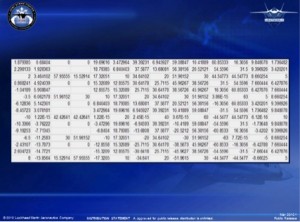
Now to a way to think about information as opposed to data.
Figure 2 is a graphical representation of the data from Figure 1.
When shown in this form it is far easier to visually communicate the data.
If you’re a mathematician or a radio frequency engineer you probably recognize Bessel curves. The Bessel curves look like decreasing sinusoids. The highest amplitude curve is the orange one that peaks at 60 on the vertical axis and coincides with 6 along the X-axis.
This is a good example of information: “the communication or reception of knowledge.”
By graphing the data it became information and we are able to gain knowledge of what the data represents.
We still do not know how to act based on this information. That comes next.
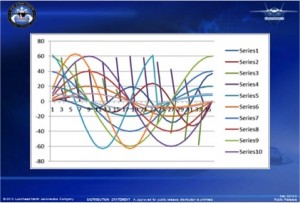
Information dominance can be understood as flowing from the significant difference between data and information.
Here is a simple task: find the peak amplitude of the red curve before your opponent who doesn’t have a graph. You can do that visually in just a moment – it’s 40.
In this exercise your task was to find the peak value of the red curve in order to win. This became a trivial task because the data was transformed into graphical information and you were told how to act upon it.
Dominance is the goal in tactical aviation. Being second best in a combat situation is not a path to survival.
The “dominant must exert control and influence over the adversary” in order to prevail.
Information dominance determines winners and losers in the information age.
Sensors and datalinks have progressed to the point that we have a glut of data in the cockpit.
This glut quickly becomes information overload rather information dominance if not dealt with properly.
This is the decision making challenge: how to turn information overload into information dominance.
Enter advanced sensor fusion … one of the hallmarks of the 5th generation fighter.
Let’s look at the processing models that have lead up to advanced sensor fusion and provide an effective pathway from information overload a decision atrophy to information dominance and effective combat decision making.
Sensor Fusion as a Tool for Information Dominance
In this section, I am going to look at three variant approaches to putting the data together to ensure that I have the information to conduct combat operations.
Each of these approaches provides a way to deal with the problem, but only advanced fusion, the third model enables one to move ahead towards information dominance.
The Additive Approach
In the first processing model or approach (figure 3) is built around an additive process, whereby sensors are added to the airplane, but left up to the pilot’s brain and experience to do the fusion.
As each new sensor or datalink was added the pilot was tasked with individual controls and displays. Each sensor had its own display and control panel. There were segregated paths from sensor through processor to display.
We then tasked the pilot to manage the bevy of disparate sensors all the while flying an extremely complex aircraft.
The information from these sensors was good and no pilot would think of going into battle without them, but there was a problem: information overload. The pilot was relegated to the role of sensor manager and that left little time to be a tactician. To complicate the situation sensor correlation and fusion was accomplished within the pilot’s mind.
A Strike Eagle weapon systems operator (WSO) told me that he had a display for radar, a display for electronic warfare, and another display for datalink. It was his task to scan the three displays, make control inputs, and then build a mental picture of battlespace for the pilot and then communicate this picture to the other members of the flight.
The four WSOs in the flight verbally exchanged what they were seeing on their displays in order to build a consolidated picture of battlespace.
Experienced WSOs did this extremely well, but it takes hundreds of hours to become an experienced WSO and even more to get really good working as an integrated team.
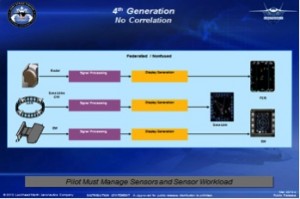
Correlation Sensor Suite Approach
The second model built out from the first. The correlation sensor suit was built upon simple correlation between sensors and datalinks.
This is an important step toward sensor fusion.
Many later fourth generation fighters now incorporate some level sensor correlation.
Correlation can be accomplished at many levels, but the easiest is at the display level.
Display correlation combines the various sensor and datalink information onto a single display. This has the advantage of “one stop shopping” for the view of battlespace.
The disadvantage is track clutter.
Each sensor and datalink shows all of its information at the same time on the same display. What is needed is a means of combining tracks and fusing their identities in order to declutter the picture.
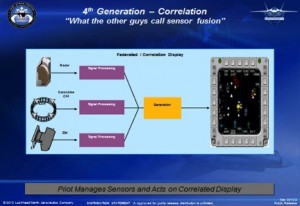
The Fusion Engine Approach
The third model is what characterizes fifth generation fighters.
This is too often confused with stealth, but really as about stealth enablement for a flying fusion engine.
Advanced sensor fusion in 5th generation fighters performs three distinct functions: build the picture, task the sensors, then communicate the result.
Notice there is an extremely tight control and performance feedback loop being executed by the advanced sensor fusion engine.
This loop essentially isolates the pilot from the drudgery of controlling and monitoring the individual sensors.
The output from the advanced fusion engine is a picture of battlespace. It is designed to be easily interpreted by the pilot so that he can act quickly and decisively.
Remember, the dominant will exercise his OODA loop more quickly than his opponent.
The picture is the most visible part, but there is much going on behind the scene.
Automatic sensor control is giving time back to the pilot and the system is automatically communicating results with the other aircraft on the link.
This is time needed to make decisions and act upon the situation.
The F-35 and Advanced Sensor Fusion
The following sections highlight the major functions of advanced sensor fusion as it exists in the F-35 Lightning II.
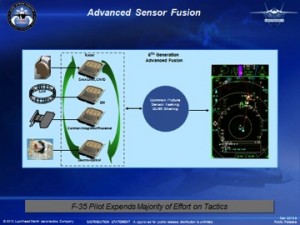
The picture is a fused and correlated view of battlespace.
The Tactical Situation Display
The Tactical Situation Display (TSD) is where the fusion engine’s picture is displayed.
The TSD is the largest window in Figure 6.
Now, instead of the pilot monitoring a separate display per sensor, fusion presents a single integrated common operational picture (COP) on the TSD. The picture is an easy to interpret graphical representation of what surrounds ownship. It is color coded such that red diamonds, green circles, and yellow squares correspond to foe, friend, and suspect.
The differing geometric shapes are used for redundant coding so that color alone is not relied upon for identification.
Combat identification (CID) is performed automatically by using all of the information from each onboard sensor as well as offboard datalinks.
Another key aspect that enhances situation awareness is the use of common symbols across the services and international fleet of F-35s.
In legacy fighter cockpits there are differing symbol sets.
There is a lot of learning and a high potential for misunderstanding as pilots communicate. Whether pilots are flying an F-35A, B, or C model, they use the exact same symbol set.
With the F-35, pilots are speaking the same language – no matter their service or nation – and using the exact same terms to describe what they’re seeing and how they’re interacting with the display.
It’s very graphical and very clear to the fleet. Its simplicity and standardization will one day enable ground commanders to easily use the pilot’s picture for an improved perspective on the battlefield.
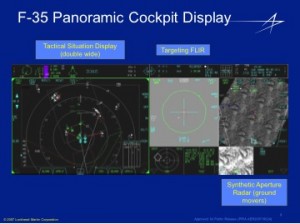
Providing for Decision-Making Tools
5th generation advanced sensor fusion is more than a fused and correlated picture of battlespace.
The fusion engine controls the sensors and tasks them automatically to fill in data and combat identification holes. As each sensor reports kinematic and identification data, the fusion engine notes the data that is missing or data that would be better reported from a different sensor.
For example, a high resolution scanning infrared search and track system may report extremely accurate azimuth and elevation data, but poor or no range data. The radar, on the other hand, may report fair angles and very accurate range. Fusion will task the radar to stare along the IRST line of sight to measure the range.
Fusion then combines these two sensors into a “best features” kinematic solution. Fusion does this for every track and every sensor, as appropriate. Automatic sensor tasking occurs in the background and without pilot involvement.
Advanced sensor fusion goes beyond the ownership of a single cockpit. It is part of a fleet.
It connects in order to communicate with the other fusion engines through a high speed network.
This affords tremendous synergy as 5th generation fighters operate together in a connected OODA loop sharing sensor information. The pilots all see the same picture on their tactical situation displays.
As an individual airplane builds the picture, it is shared with the other fighters on the network.
Don’t misunderstand, we don’t share the graphical picture – we share the fusion contents in such a manner that each participating fusion engine can build its own graphical depiction for the pilot. In similar fashion to how fusion uses the best data from each sensor to build a better kinematic and ID solution it also uses every other fusion engine’s contribution to do the same thing.
Why is this important?
Here is a simple example.
Suppose the enemy is able to attack and defeat a sensor on one aircraft. Fusion will exclude data from that sensor and use another sensor or even another aircraft’s fusion results. The chances of the enemy being able to attack and defeat every sensor on every connected 5th gen fighter at the same time are almost impossible.
The synergy of connected fusion engines is one of the hallmarks of the 5th generation.
In the 5th generation the Common Operational Picture or COP is assembled and shared by each aircraft.
The shift from radio to a visual COP is a key definer in the shift from legacy aircraft to 5th generation fighters. With the COP (generated by fusion from all of the sensors and then presented in an easy-to-understand graphical view of battlespace) the pilots now share common situational awareness.
This is a multiplier in terms of lethality and survivability, but perhaps most importantly – it doesn’t increase workload.
The pilot is returned to the role of tactician.
Twenty years ago radio was the tool used by pilots to create synergy. A good flight lead had to describe battlespace to his wingmen. If you couldn’t describe battlespace and build a picture inside everyone’s mind, then it was difficult to maintain mutual support and to generate combat synergy.
Modern 4th generation fighters with datalinks have improved information sharing, but they are not typically well integrated into the weapon system. They are an add-on, much like a new sensor or new pod and must be managed and mentally correlated.
Fifth generation advanced sensor fusion does not depend on the pilot’s ability to mentally fuse and correlate multiple sensors into a picture and then communicate it verbally.
The planes share the picture automatically which means Blue 4, a brand-new 5th gen pilot, sees the same picture as Blue 1 is seeing who has 1,000 hours in the jet.
The shared COP is the key enabler for combat synergy.
It is synergy in a picture rather than words.
Of course, looking at the COP for a pilot with 1,000 hours of experience is going to be different than for a new pilot on his or her first mission. You can’t teach airmanship, but we can bring the valleys of inexperience up quickly and in such a manner that we have a positive effect on lethality and survivability.
Mitigating Information Overload
Let’s go back to Col Boyd’s OODA loop.
Figure 7 depicts an early 4th generation fighter with disparate sensors, datalinks, and displays. In this situation the pilot is controlling multiple sensors whose data is being shown on multiple displays.
This requires the pilot to build a mental picture of battlespace.
Fourth generation aircraft have added disparate technological capabilities, which can lead to information overload.
For instance, datalinks; datalinks are great tools and nobody wants to do without it them, but when not fully integrated into an advanced fusion architecture they contribute to information overload for the pilot.
The needed information is there – somewhere – it’s just hard to find it, to mentally correlate, and then to act on it.
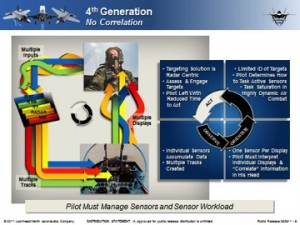
Information overload leads to pilot task saturation and channelized attention which is deleterious to survival. Pilots may become preoccupied trying to interpret information when they need to be focused elsewhere.
Here’s an example to which we can relate: you’re driving while studying the GPS and making a simple control input. Your driving performance is affected and your safety is being compromised because of misdirected focus and channelized attention.
The same holds true in the cockpit.
Displays are focus magnets.
They drain more and more of the pilot’s mental processing capacity as it takes an increasing amount of attention to interpret the data. Consequently, performance and safety are compromised.
In tactical fighters this equates to impaired lethality and survivability.
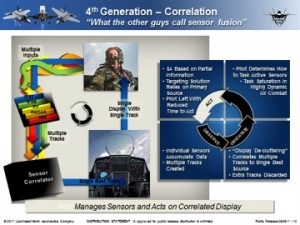
The ability to turn situation awareness into dominance is the hallmark of 5th generation advanced sensor fusion.
The pilot requires information that is presented in an easy to consume format.
Another example to consider: when I was a new F-16 pilot we were tasked to fly against some fighters that had just gotten JTIDS installed. The JTIDS network gave them tremendous situation awareness of the battlespace. Every track, friend or foe, velocity, altitude, and aspect was displayed on top of the radar display – it was a cacophony of information and very cluttered.
Information overload does not equate to information dominance.
We joked in the debrief: “they died with more SA than anyone.”
It wasn’t that we were extremely good and they extremely bad, but their information display was not being presented in an easy to consume format.
They became glued to the head down display and completely forgot about the visual fight that was ensuing out the canopy.
Most 4th generation fighters have now integrated sensor correlation as depicted in figure 8.
This is a significant step that places information from multiple sensors onto a single display and in some cases correlates the tracks. Sensor correlation works to provide a decluttered picture of battlespace.
A correlated sensor picture is important, but it is only one third of the equation. The pilot is still tasked with controlling the sensor suite and then communicating the picture with the others members in the flight.
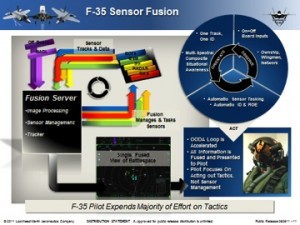
Figure 9 depicts the 5th generation advanced sensor fusion suite in OODA loop form.
This design is fully integrated with the sensor control and display suite in order to provide the picture, perform automatic sensor tasking, and connectivity with the other fusion engines on the datalink.
In the 5th generation the advanced sensor suite is planned and built in from the inception of the weapon system.
Advanced sensor fusion is one of the hallmarks of the 5th generation.
Its contribution is far more than situation awareness and manageable workload. It provides information dominance.
Information dominance determines winners and losers in tactical aviation.
Addendum: Definitions
- Data – information in numerical form that can be digitally transmitted and processed (Merriam-Webster)
- Information – the communication or reception of knowledge or intelligence (Merriam-Webster)
- Dominance – the influence or control […] exerted by the dominant (Merriam-
- Webster)
- Information Dominance – the ability to use information in such a manner that you dominate over an opponent.
Mike Skaff has worked on the evolution of pilot cockpits and the processing of information for those cockpits for many years. He was a major contributor to the success of the F-16 cockpit and is the Principal Engineer for the F-35’s pilot vehicle interface .
A PDF version of this article can be downloaded here:
We published earlier a discussion between Ed Timperlake and Mike Skaff on how the fusion engine is an input to a new approach for pilot learning as well.
https://sldinfo.com/shaping-a-new-approach-to-combat-learning-the-role-of-the-f-35/
Editor’s Note: In the video at the beginning of the article, Lt. Col. Berke, the only F-22 and F-35 in existence, discusses his view of the 5th generation experience highlighted by Skaff. Berke has more than 2800 flight hours in F-18s, F-16s, F-22s and F-35s and is a consumer of the work which Skaff and his team have done in shaping the fusion engine cockpit.
Without ever having met Skaff, Berke mentioned, during the interview in August 2012, that “I don’t know who designed the F-35 cockpit, but he is a genius.”

